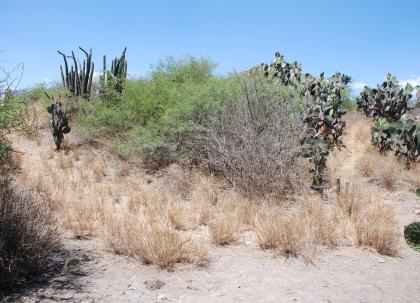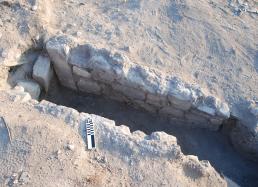2: Making Lemonade and Getting Started at Lambityeco
For more than a decade during archaeological projects, we've employed the same great cook (Elena) when living in Mitla. Among her many specialties are the fruit drinks, or agues, that she makes most nights for our suppers, or cenas. All of her drinks—melon, papaya, watermelon, pineapple, orange—are really good (especially after a long, hot day at the site in the sun), but my personal favorite is the drink that she makes from the little Mexican limes, or limones, which we just call lemonade. Needless to say, changing field plans on the fly may be considered a bit sour like lemons, but so begins our story of making lemonade from this turn of events.
As you can imagine, starting a truncated field season at a renowned site where we've never investigated before presents a number of challenges. And yet, this change in plans has also opened up a far greater number of welcome opportunities. To begin with, this field season offers both the potential to collaborate even more closely with our Mexican colleagues in Oaxaca, something we've long aimed to do, while also providing another chance to present our archaeological findings to a broader public.
Should INAH’s (Mexico’s National Institute of Anthropology and History) archaeological zone at Lambityeco someday be expanded (as tentatively planned), it's conceivable that our findings from this year (and perhaps beyond) might be included or incorporated into what is on display. The chance to work this year at Lambityeco also yields many research opportunities, especially the possibility to compare an elaborate residence at this site with our prior studies at El Palmillo.
We're also excited with the prospect that we'll be able to continue to work with our local crew from Mitla. Many of these people have two, three, and even more seasons of experience with us in the field, and having them continue with us makes our transition to a new site much more manageable.
When we were given the chance to investigate at Lambityeco by INAH, we had to decide where on INAH's newly purchased land we should focus, and we had to implement a plan that allowed us to get started as soon as possible. Many logistical issues had to be resolved. How would we get our Mitla crew back and forth to Lambityeco, roughly 20 km away? How would we fit all our analysis activities into the small lab space at Lambityeco? And most critically, would the different physical setting of Lambityeco (as compared to the Mitla Fortress and El Palmillo) have much impact on how we work, the kinds of interpretations we make, and what we find.
Although Lambityeco reached its greatest extent during the Late Classic period (ca. A.D. 700-850), similar to El Palmillo, the location of the two sites is totally different. El Palmillo is a hilltop settlement like the Mitla Fortress, but El Palmillo is situated on a much higher hill that, in turn, is linked by ascending ridges to even taller mountains.
In contrast, Lambityeco is located on a broad, flat swath of alluvial ground. It's situated in an area that today generally receives somewhat more precipitation than either the Mitla Fortress or El Palmillo, and in the past, the residents likely exploited a higher water table than available in hilly uplands. Today, there isn't a great deal of farming around either site, but whereas cacti and succulents are most abundant at El Palmillo, the contemporary plant life around Lambityeco consists principally of thorny trees and shrubs, such as mesquite.
Because of these differences between Lambityeco and the two sites where we've most recently excavated (El Palmillo and the Mitla Fortress), we chose an excavation location at Lambityeco that we thought might be familiar in certain respects, while at the same time providing ready comparative angles to studies we've implemented before.
More specifically, we elected to excavate a low, broad-topped mound or platform that we (as well as other archaeologists who've investigated the site) suspected was an elaborate residence. Since we'd excavated three elaborate, Late Classic-period residences at El Palmillo, the opportunity to make systematic observations regarding differences and similarities in the nature of high-status life at the two contemporaneous towns seems great.
At Lambityeco, we also have the chance and responsibility to build on the work of many prior archaeologists, including the late John Paddock, who began research at the site in 1961. Paddock and colleagues excavated what may be the most elaborate high-status residence at the site, which now is the focus of the consolidated ruins in the archaeological zone.
Even though the platform that we've elected to study is adjacent to Lambityeco's tallest earthen mound (approximately 12 meters in height, likely sustaining a temple structure), we don't expect that it will be nearly as elaborate as the residence excavated years back by Paddock. But we do expect that Paddock’s discoveries in what is now named Mound 195 will provide an additional aspect for focused comparison and contrast.
Unfortunately, we're not the only ones who've suspected that the platform where we're now working looked like an interesting place. It's hard to fathom this attention, given that the platform was covered with thick, thorny vegetation that made it almost impossible to see (note above photo.) Yet sadly, the mound we elected to investigate has been the locus of persistent looting, including recent destructive forays that broke into and cleared out a domestic tomb that was part of this mounded feature.
We recognized the wounds from this illicit grave robbing when we began and knew that it would make our interpretive efforts more challenging. But we also recognized our responsibility to salvage whatever information we could learn from this complex before it was totally decimated (see Photos #1 and #2 below.) Unquestionably, much information lamentably was lost to the pot hunters and is irretrievable, and yet in a future dispatch I'll discuss how, with the help of our bioarchaeologist (Keitlyn Alcantara), we were able to salvage some key data concerning this burial feature and its relationship to the residential complex as a whole.
More soon,
Gary






